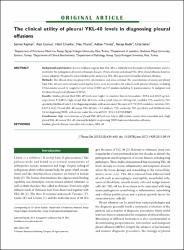| dc.contributor.author | Kayhan, Servet | |
| dc.contributor.author | Gümüş, Aziz | |
| dc.contributor.author | Çınarka, Halit | |
| dc.contributor.author | Murat, Naci | |
| dc.contributor.author | Yılmaz, Adnan | |
| dc.contributor.author | Bedir, Recep | |
| dc.contributor.author | Şahin, Ünal | |
| dc.date.accessioned | 2020-12-19T20:04:00Z | |
| dc.date.available | 2020-12-19T20:04:00Z | |
| dc.date.issued | 2013 | |
| dc.identifier.citation | Kayhan, S., Gumus, A., Cinarka, H., Murat, N., Yilmaz, A., Bedir, R., Sahin, U. (2013). The clinical utility of pleural YKL-40 levels in diagnosing pleural effusions. Journal of Thoracic Disease, 5(5), 634-640. https://doi.org/10.3978/j.issn.2072-1439.2013.09.19 | en_US |
| dc.identifier.issn | 2072-1439 | |
| dc.identifier.issn | 2077-6624 | |
| dc.identifier.uri | https://doi.org/10.3978/j.issn.2072-1439.2013.09.19 | |
| dc.identifier.uri | https://hdl.handle.net/11436/3267 | |
| dc.description | Kayhan, Servet/0000-0003-4226-2781; yilmaz, adnan/0000-0001-9769-9791 | en_US |
| dc.description | WOS: 000328462500017 | en_US |
| dc.description | PubMed: 24255777 | en_US |
| dc.description.abstract | Background and objective: Recent evidence suggests that YKL-40 is a relatively new biomarker of inflammation and it is involved in the pathogenesis of several pulmonary diseases. Details of serum and pleural YKL-40 in pleural effusions however, remain unknown. We aimed to assess whether serum and pleural YKL-40 is an accurate biomarker of pleural effusions. Methods: This clinical study was prospective, observational and cross-sectional. the concentrations of serum and pleural fluid YKL-40 and conventional pleural marker levels were measured in 80 subjects with pleural effusions, including 23 transudates caused by congestive heart failure (CHF), and 57 exudates including 23 parapneumonic, 22 malignant and 12 tuberculous pleural effusions (TBPEs). Results: Median pleural fluid YKL-40 levels were higher in exudates than in transudates (219.4 and 205.9 ng/mL, respectively, P<0.001). High pleural YKL-40 levels, with a cutoff value of >215 ng/mL, yielded a 73% sensitivity, 73% specificity, likelihood ratio 2.8 for diagnosing exudate, with an area under the curve of 0.770 [95% confidence intervals (CI): 0.657-0.884]. Pleural YKL-40/serum YKL-40 ratio >1.5 yielded a 75% sensitivity, 72% specificity and likelihood ratio 2.6 for diagnosing TBPE, with an area under the curve of 0.825 (95% CI: 0.710-0.940). Conclusions: High concentrations of pleural YKL-40 level may help to differentiate exudate from transudate and a high pleural YKL-40/serum YKL-40 ratio may be helpful in seperating TBPE from non-tuberculous effusions. | en_US |
| dc.language.iso | eng | en_US |
| dc.publisher | Pioneer Bioscience Publ Co | en_US |
| dc.rights | info:eu-repo/semantics/openAccess | en_US |
| dc.subject | Exudate | en_US |
| dc.subject | Pleural effusion | en_US |
| dc.subject | Transudate | en_US |
| dc.subject | Tuberculosis | en_US |
| dc.subject | YKL-40 | en_US |
| dc.title | The clinical utility of pleural YKL-40 levels in diagnosing pleural effusions | en_US |
| dc.type | article | en_US |
| dc.contributor.department | RTEÜ, Tıp Fakültesi, Dahili Tıp Bilimleri Bölümü | en_US |
| dc.contributor.institutionauthor | Kayhan, Servet | |
| dc.contributor.institutionauthor | Gümüş, Aziz | |
| dc.contributor.institutionauthor | Çınarka, Halit | |
| dc.contributor.institutionauthor | Yılmaz, Adnan | |
| dc.contributor.institutionauthor | Bedir, Recep | |
| dc.contributor.institutionauthor | Şahin, Ünal | |
| dc.identifier.doi | 10.3978/j.issn.2072-1439.2013.09.19 | |
| dc.identifier.volume | 5 | en_US |
| dc.identifier.issue | 5 | en_US |
| dc.identifier.startpage | 634 | en_US |
| dc.identifier.endpage | 640 | en_US |
| dc.relation.journal | Journal of Thoracic Disease | en_US |
| dc.relation.publicationcategory | Makale - Uluslararası Hakemli Dergi - Kurum Öğretim Elemanı | en_US |


















